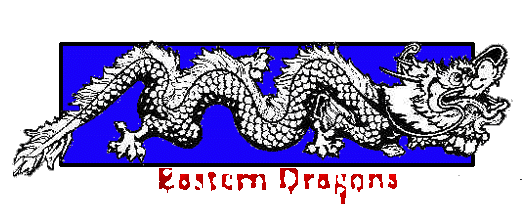

Most aisian dragons share the same, general appearance. You most likely have seen them somewhere in a Chinese resturant, or on the cover of a Kung Fu movie. Today, eastern dragons have lost their original significance. They are traditionally creatures of the Water: they bring the rains, and dwell in rivers, lakes, pools (the NATURAL kind) and oceans. However, they are now little more than a fierce symbol of the Martial Arts and fine dining ( can we say 'sizzling rice soup?' mmmmmmmmm). They are keepers of great knowledge and power. Their favorite food is the swallow (as in the bird) so, anybody smelling fowl (as in bird like) is in danger of indadvertantly becoming dragon food. Some exemplary Eastern Dragon information can be found at The Encyclopedia Mythica where I did a little bit of research, which resulted in a new E-mail Adress.
I have lumped India into the Aisian dragon regieme, as the Indian Naga was a great influence on the way the Chinese viewed dragons. Nagas protect the life giving influence of water, and are generally regarded as benign. They usually have multiple heads and bear great wisdom. As a result of this (wisdom I mean) Nagas have gained human characteristics in many regions of India and in modern culture. Today you will find Nagas as being half serpent/half human. Without further adieu, here is a listing of Aisiatic Dragon "species":
In chinese Mythology, dragons are one of the four ling which also consists of the phoenix, the turtle, and the kirin (unicorn). Dragons are usually referred to as Lung or Long, depending on the translation you read.
Numbers have quite a bit to do with aisiatic dragons, from their toes to the scales on their backs!! Dragons with 3 toes are usually Japanese, but ancient Chinese dragons also had three toes. 4 toed dragons are Earth dragons, and also found in Korea (referred to as mang) Dragons with 5 toes are Chinese Imperial Dragons; in ancient times, a peasant seen wearing a five toed dragon was put to death!!! A dragon has 81 scales on its back, as 9 is an auspicious number, and 9 is the square root of 81.
India:

Naga was the generic Indian dragon. They lived in the underworld and were the enimies of Garuda, the Eagle Man god. They were however, generally benign. They guarded the life giving properites of water.
China:
Lung: the generic name for the chinese dragon.
Tien Lung: the Celestial Dragon- guarded the gates of heaven. Blue in color.
Shen-Lung: Rain dragons
Fu-ts'ang Lung: guardian of earthly treasures (gold, jewels...)
Ying-Lung: Winged Dragon ( sent by an emperor to kill off the nasty Ch'ih Yu, an 8 fingered nasty river dragon)
Chiao: marsh dwelling dragon
Li: hornless dragon associated with earth rivers and oceans.
Japan:
Tatsu: generic term for the japanese dragon.
Sui-Riu: Dragon King
Han-Riu: multi-striped, 40 feet long
Ri-Riu: a dragon with exceptial vision
Hai-Riu: Winged dragon
Ka-Riu: firey red, but only 7 feet long.
Fuku Riu: a good luck dragon. 